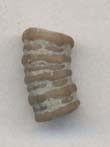Ordovician Echinoderm Fossils
Echinoderms form a well-defined and highly-derived clade of
metazoans. They have attracted much attention due to their extensive
fossil record, ecological importance in the marine realm, intriguing
adult morphology, unusual biomechanical properties, and experimentally
manipulable embryos. The approximately 7,000 species of extant
echinoderms fall into five well-defined clades: Crinoidea (sea lilies
and feather stars), Ophiuroidea (basket stars and brittle stars),
Asteroidea (starfishes), Echinoidea (sea urchins, sand dollars, and
sea biscuits), and Holothuroidea (sea cucumbers).
Click on any image to see a larger, more detailed
view
Class:Crinoidea
|
Genus/species:
|
Cincinnaticrinus pentagonus
|
|
Images
|


|
|
Notes:
|
A proximal stem section from Cincinnaticrinus pentagonus. Note the
pentagonal cross section. Specimen is .75 cm long and .39 cm wide.
|
|
Genus/species:
|
Cincinnaticrinus pentagonus
|
|
Images
|

|
|
Notes:
|
Fragment of a crinoid stem 2.91 cm in length.
|
|
Genus/species:
|
Cincinnaticrinus pentagonus
|
|
Images
|

|
|
Notes:
|
Fragment of a crinoid stem 1.25 cm in length and .45 cm wide.
|
|
